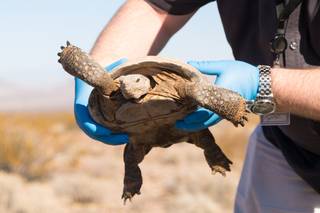The Boulder City Conservation Easement welcomed five new desert tortoises Tuesday in an effort to improve the long-term survivability of this beloved, threatened species.
The tortoises — three male and two female — were all recovered earlier this year from private construction sites around Clark County. Scott Cambrin, a senior biologist with Clark County, said the tortoises were picked up through the county’s Multiple Species Habitat Conservation Program.
The program has spent more than $154 million on more than 600 conservation projects to protect species impacted by encroaching growth and development.
“The program runs a desert tortoise hotline that any construction company can call,” he said.
Construction personnel can call the hotline when they see a desert tortoise on site, and officials with the conservation program will pick them up free of charge. State and federal law prohibits any unlicensed person to own, touch, harm or harass the tortoises, making this hotline a necessity.
The tortoises, which were held over the summer for medical screenings, will have no problem acclimating to their new environment, Cambrin said, as the fall temperatures are ideal for release. They’re also “pretty darn quick in building their own homes,” he said.
The conservation easement, located two miles south and west of Boulder City, was first established in 1995 and is just above 87,000 acres of habitat primarily for the benefit of desert tortoises. Right now, conservation program plans to install around 11,000 miles of desert tortoise exclusionary fencing around the perimeter of the area.
Cambrin said the tortoise population density hovers around 1.9 per square kilometer. Ideally, he’d like to get that number up to four, as low-density populations are unlikely to persist over time.
“We have done some work with U.S. Fish and Wildlife Service to look for places with a low number of tortoises … we find areas that have low (populations), and we release tortoises there to raise that number,” he said. The organization also works on conservation efforts to protect other desert species including the endangered Mount Charleston blue butterfly and yellow-billed cuckoo.


